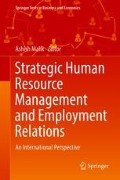Abstract
Therese Sevaldsen was the Head of Human Resources at Philips Middle East and Turkey, based in the regional headquarters in Dubai, UAE. Throughout her years at Philips, she had led major HR transformation projects. Her passion, dedication and expertise had placed her as an influential role model at Philips. She was known to be business oriented, passionate about people, and a strong advocate for women in leadership. She adopted a leadership style which was inclusive and based on trust. In addition, she tried to be an inspirational leader, providing clear direction, encouraging her team to challenge the status quo, and leading them to implement new innovative HR solutions that better served internal and external customers. Prior to her role at Phillips, Therese was the Head of HR for Schneider Electric in Dubai, a fortune 500 Company with 2000 employees across 14 countries, and 1 billion EUR revenue. Before this she had a number of business partner roles in Schneider Electric and other companies in the lighting and high tech industry. Therese was a mother of two school-aged boys. She enjoyed balancing her personal life with a very successful career. Activities like building Lego structures with her boys, and family Sci-Fi movie evenings gave her immense pleasure. She had just returned from a Best Practices session, held this morning at the Dubai Business Women’s Council, as part of the International Women’s Day celebrationsfor 2017, in which her CEO had spoken about the various steps Philips was taking to ensure gender equality. It was only 2 days before, that Therese and her team at Philips MET had received news that they had won an award for being among the best places to work within the UAE. This accolade was further validation for the key value espoused by Philips, which had people at its core (Exhibit 1). Further, as the Performance highlights in 2015 indicated, 1.7 billion lives had been improved by Phillips Green Products alone, 0.88 billion lives by Phillips Care Products and 0.3 billion by Phillips wellbeing products (Philips Annual Report 2015, and Exhibit 2).
Access this chapter
Tax calculation will be finalised at checkout
Purchases are for personal use only
Notes
- 1.
Available http://www.mea.philips.com/a-w/about/news/archive/standard/news/2016/20160212_Philips_MoU_release.html, accessed 10th May, 2016.
- 2.
Source: Available, http://www.mea.philips.com/aw/about/news/archive/standard/news/2016/20161207-philips-avent-launches-uae-initiative-to-support-breast-pumping-facilities-in-the-workplace.html, accessed 15th May, 2017.
Acknowledgements
The case study is written as part of a larger research project, led by Principal Investigator, Payyazhi Jayashree, University of Wollongong in Dubai (UOWD), in collaboration with Co-investigator, Valerie Lindsay, funded by United Arab Emirates National Research Foundation (NRF), University-Industry Research Collaboration Award (2015), and the key Industry partner, Dubai Business Women Council (DBWC), which ‘established in 2002, under the umbrella of the Dubai Chamber of Commerce and Industry, is the official representative organization for business women, both professionals and entrepreneurs, in the Emirate of Dubai’ (available, http://www.dbwc.ae/). The research focusses on examining workplace engagement and leadership among women in the UAE and the authors gratefully acknowledge the contribution of both DBWC and NRF towards this research.
Author information
Authors and Affiliations
Corresponding author
Editor information
Editors and Affiliations
Case Study Questions
Case Study Questions
-
1.
Research provides evidence that organisations that invest in Diversity and Inclusion are more innovative in the long run and outperform organisations that do not.
-
Critically evaluate the significance of Diversity and Inclusion (D&I) as a strategic imperative, with specific reference to the relevance of strategic alignment to achieve D& I goals at Philips.
-
What would be the key elements of this D&I Strategy?
-
-
2.
Stereotype threat, “arises when one is in a situation or doing something for which a negative stereotype about one’s group applies” (Steele 1997:614) and has the potential to lower the motivation and performance of the person who identifies with the group being stereotyped.
-
Critically evaluate, using relevant literature, the conditions that foster stereotype threat.
-
Discuss the strengths of the HR interventions that are already introduced by Phillips to build a gender-inclusive culture. Provide a clear direction for the specific talent-management strategies that Phillips can develop, to ensure that a pipeline is created, to strengthen gender diversity at multiple levels of the organisational hierarchy.
-
-
3.
As stated in the case, Therese strongly believes that the changes she was seeking for women in the workplace, were the dual responsibility of organizations and women themselves.
-
Critically evaluate the significance of Leadership Capacity Development and proactively taking ownership for one’s career, for women at the workplace, with specific reference to relevant literature and to the facts presented in the case.
-
-
4.
The Social Justice case for D&I has been argued in strategic human resource management literature as having longer term impact in building an inclusive culture, as opposed to the Business Case, focussed on legislative compliance, which is considered to be short-term. Critically evaluate the above statement and discuss (in the context of the above case and relevant scholarly literature), the specific steps that can be taken by the Leadership team, to foster an inclusive culture focused on workplace diversity.
Rights and permissions
Copyright information
© 2018 Springer Nature Singapore Pte Ltd.
About this chapter
Cite this chapter
Jayashree, P., Sevaldsen, T., Lindsay, V. (2018). Case 11: Gender Inclusive Leadership for Innovation and Change: An HR Head’s Reflections. In: Malik, A. (eds) Strategic Human Resource Management and Employment Relations. Springer Texts in Business and Economics. Springer, Singapore. https://doi.org/10.1007/978-981-13-0399-9_25
Download citation
DOI: https://doi.org/10.1007/978-981-13-0399-9_25
Published:
Publisher Name: Springer, Singapore
Print ISBN: 978-981-13-0398-2
Online ISBN: 978-981-13-0399-9
eBook Packages: Business and ManagementBusiness and Management (R0)

